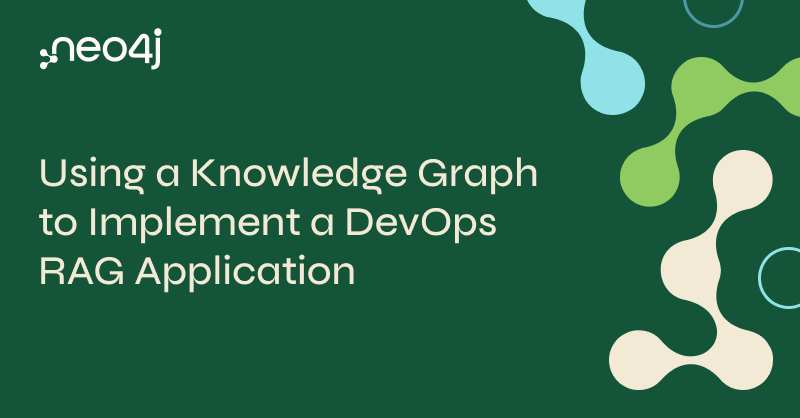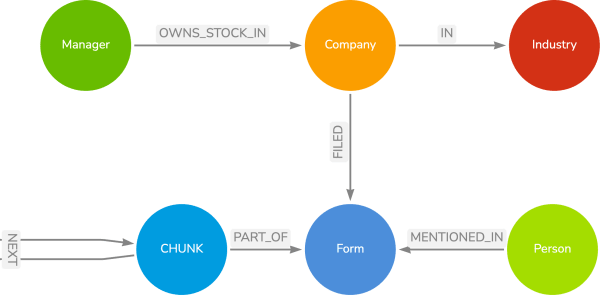Neo4j for GenAI
Unify vector search, knowledge graph, and data science to build breakthrough GenAI apps that deliver highly accurate responses, rich context, and deep explainability.
Integrate Domain Knowledge
Incorporate and connect organizational data and facts for tailored accurate responses
Enrich Responses With Context
Connect related facts across your data for more accurate and meaningful answers
Explain Retrieval Logic
Trace sources and understand connections between knowledge and responses
Accelerate AI & Agent Development
Seamlessly integrate with MCP, leading orchestration frameworks, and multi-agent systems
The GraphRAG Manifesto: Adding Knowledge to GenAI
Discover why GraphRAG will subsume vector-only RAG and emerge as the default RAG architecture for most use cases
GraphRAG Explained
Discover a smarter way to build GenAI apps with Neo4j GraphRAG. By combining knowledge graphs and vector search, GraphRAG infuses your AI with deep context and multi-hop reasoning for more accurate, relevant, and explainable results.
Capabilities
Build Your Next GenAI Breakthrough
Transform data from multiple sources into a graph-based model of entities, their attributes, and how they relate. Continuously enrich the graph by adding new data to uncover patterns and hidden relationships.
Learn More
Build smarter apps with fast semantic search across various data types. Find contextually related information and recommend connections based on similarity metrics.
Learn More
Analyze data connections and uncover deeper insights using 65+ production-ready algorithms for improved predictions and decision-making.
Learn MoreAccelerate GenAI app development with our integrations for popular AI frameworks and tools. Seamlessly incorporate graph capabilities into your projects using LangChain, LlamaIndex, Hugging Face, and more.
Learn More
Develop GenAI applications using the LLMS and services that best fit your needs, including state-of-the-art models and GenAI services from OpenAI, Google (Gemini and Vertex AI), Microsoft Azure OpenAI, Amazon Bedrock, as well as open-source models from HuggingFace, Ollama, and others. With Neo4j, you can build powerful, scalable, and context-driven GenAI solutions with minimal complexity.
Learn More




Top Use Cases for Graph & AI
Create Knowledge Graphs for Accurate and Explainable Results
Quickly transform structured and unstructured data into a rich, connected knowledge graph. Our intuitive tools and workflows streamline the process of extracting entities, facts, and relationships from text, enabling you to create a powerful foundation for your GenAI app in minutes, not days.
Transform Interactions With GenAI-Powered Applications
Elevate customer engagement across all touchpoints with intelligent, context-aware chatbots built on Neo4j. By Combining knowledge graphs, vector search, and LLMs, Neo4j enables you to create chatbots that deliver accurate, personalized, and efficient interactions, improving customer satisfaction and driving loyalty.
Enhance Search
With GenAI and
Knowledge Graphs
Deliver a better search experience with GenAI-powered semantic search, built on Neo4j knowledge graphs. Graph-backed Search understands user intent, surfaces relevant results, and provides contextual recommendations, delivering a more intuitive and satisfying search experience.
Loved by Devs. Deployed Worldwide.
1,700+ organizations build on Neo4j for data breakthroughs.
Real World AI Innovations. Powered by Graph.
Explore GenAI Resources
Tools and guides for building cutting-edge GenAI-powered apps.
Neo4j & LLM Fundamentals
Learn the basics of Neo4j and the property graph model
4 hours
Importing Data Fundamental
Learn how to import data into Neo4j
2 hours
Build a Neo4j-backed chatbot using Python
Build a chatbot using Neo4j, Langchain and Streamlit
2 hours
Build a Neo4j-backed chatbot with Typescript
Build a chatbot using Neo4j, Langchain and Next.js
6 hours
Introduction to Vector Indexes and Unstructured Data
Understand and search unstructured data using vector indexes
2 hours
What is GraphRAG?
Discover how GraphRAG revolutionizes GenAI by using knowledge graphs to deliver accurate, reliable, and context-rich answers.

GraphRAG Python Package: GenAI With Knowledge Graphs
Transform unstructured data into knowledge graphs and enhance GenAI retrieval

The GraphRAG Manifesto: Adding Knowledge to GenAI
Discover why GraphRAG will surpass vector-only RAG as the default architecture

Get Started With GraphRAG: Neo4j’s Ecosystem Tools
Develop GenAI applications grounded with knowledge graphs

Neo4j Brings GraphRAG Capabilities for GenAI to Google Cloud
Learn about the native integrations with Google Cloud and Vertex AI

Using a Knowledge Graph to Implement a RAG Application
Learn about RAG and what Forbes recently named the hottest thing in AI

Unifying LLMs & Knowledge Graphs for GenAI: Use Cases
Learn how knowledge graphs and large language models (LLMs) can be used together

Implementing RAG: Write a Graph Retrieval Query in LangChain
Learn how to write the retrieval query that supplements or grounds the LLM’s answer
Accelerate GenAI using the GraphRAG Python package
Learn to build knowledge graphs, implement advanced retrievers, and create GraphRAG workflows

Kickstart GenAI Dev With Neo4j’s GraphRAG Ecosystem
Learn how to quickly start a knowledge graph from unstructured data

Go From GenAI Pilot to Production Faster with a Knowledge Graph
Learn to overcome challenges with hallucinations, search, data integrations, and more

Getting Started with GenAI
Learn how to build GenAI applications for real-world use cases

Building more Accurate GenAI Chatbots
Learn how knowledge graphs can back GenAI apps

Improved Results with Vector Search in Knowledge Graph
Learn the latest AI technologies in data analysis
Start Building GenAI Breakthroughs Today!
Neo4j unifies vector search, knowledge graph, and data science capabilities to accelerate building context-rich, explainable GenAI applications.


